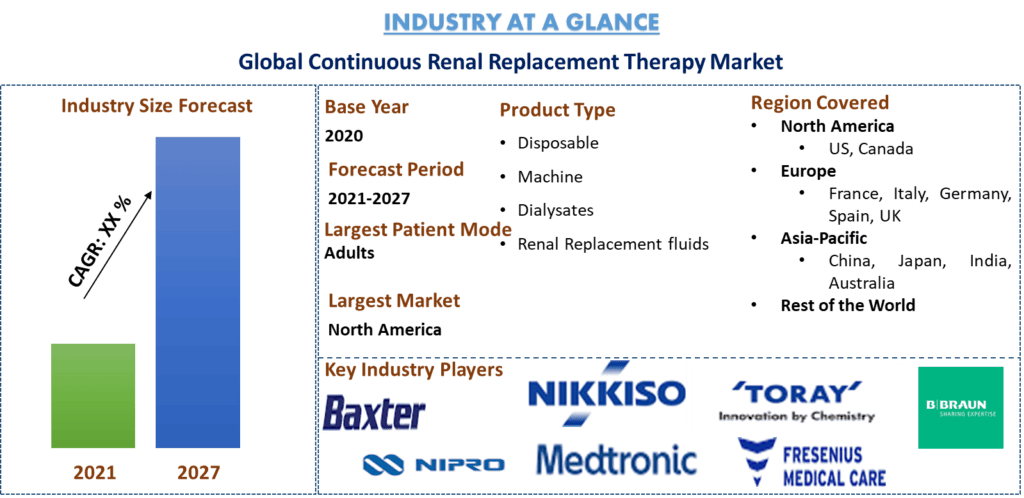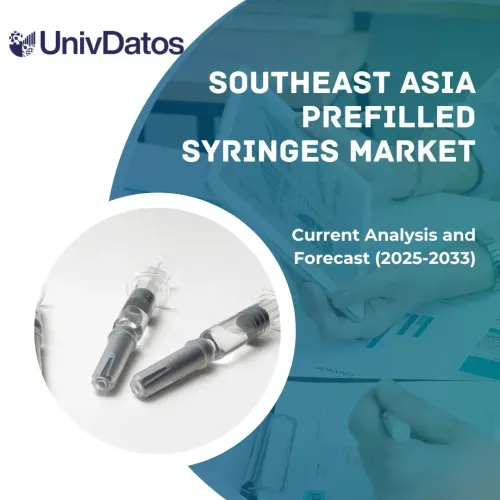- Home
- About Us
- Industry
- Services
- Reading
- Contact Us
Continuous Renal Replacement Therapy Market: Current Analysis and Forecast (2021-2027)
Emphasis on Product Type (Disposable, Machine, Dialysates, Renal Replacement Fluid); Type (Contract Renal Replacement Therapy, Sterilization Validation Services); Modality (SCUF, CVVH, CVVHD, CVVHDF); Mode of Patient (Adults, Paediatrics, Neonates); Region and Country

Continuous Renal Replacement Therapy (CRRT) Market was valued at US$ 1 billion in 2020 and is expected to grow at a CAGR of 7% over the forecast period (2021-2027). A rise in the chronic kidney disease owing to the adoption of sedentary lifestyle, stress and rising aging population are some of the prominent factors which is driving the demand of renal replacement therapy. As per CDC, More than 1 in 7, that is 15% of US adults or 37 million people, are estimated to have Chronic Kidney disease (CKD). Also, As many as 9 in 10 adults with CKD do not know they have CKD and About 2 in 5 adults with severe CKD do not know they have CKD.
Moreover, the growing incidence of AKI/AKF is expected to increase the demand for CRRT. According to the International Society of Nephrology (INR), an estimated 13.3 million cases of AKI are registered annually worldwide. This is anticipated to boost the adoption of continuous renal replacement therapy at a rapid rate. With the rapid growth in the geriatric population globally, the prevalence of kidney-related diseases is expected to increase significantly. This, in turn, is expected to propel the growth of the CRRT market at a significant rate during the forecast period.
The COVID-19 pandemic has significantly affected the CRRT market. The surge in the number of COVID cases, along with the rise in its severity rate, is likely to create a potential increase in the incidence of kidney damage. This makes AKI the next emerging healthcare concern after respiratory tract infections among patients with COVID-19. As coronavirus disease 2019 increased in early 2020, it became evident that patients infected with severe acute respiratory syndrome coronavirus 2 were at increased risk of developing AKI. In large United States cohorts studied at the beginning of the pandemic, 28%–46% of those hospitalized with COVID-19 developed AKI, and rates were markedly higher among patients requiring admission/transfer to the intensive care unit (ICU; 61%–78%).
Effect of Dynamic Circuit Pressures Monitoring on the Lifespan of Extracorporeal Circuit
Some of the prominent players operating in the market include Baxter International Inc., Fresenius Medical Care AG & Co. KGaA, NIKKISO CO., LTD., B. Braun Melsungen AG, Asahi Kasei Corporation, Toray Medical Co., Ltd. , Infomed SA, Medtronic plc, Nipro Corporation.

Insights Presented in the Report
“Amongst Product Type, Dialysates segment holds the major share.”
Based on Product type the market has been classified into Disposable, Machine, Dialysates, Renal Replacement fluid. The Dialysates segment accounted for the largest share of the Renal Replacement Therapy market in 2020. This segment’s large share can be attributed due to the significant rise in demand for CRRT in the treatment of hemodynamically unstable patients.
“Amongst Type, contract sterilization segment holds the major share.”
Based on type, the Renal Replacement Therapy market has been segmented into contract Renal Replacement Therapy and sterilization validation services. The contract Renal Replacement Therapy segment accounted for the highest CAGR of the Renal Replacement Therapy market during the forecast period.
“Amongst Modality, off-site segment dominated the market during the forecast period.”
Based on Modality, the Renal Replacement Therapy market has been segmented into SCUF, CVVH, CVVHD, CVVHDF. In 2020, the CVVHDF segment accounted for a largest share of the Renal Replacement Therapy market. The growing preference of CVVHDF modality among a nephrologist and critical care physician, and the advantages such as better clearance of medium-sized solutes as compared to hemodialysis, proper acid-base balance without additional intervention are acting as a growth catalyst for this segment.
“Amongst Mode of Patient, Adults segment dominated the market during the forecast period.”
Based on Mode of Patients, the Renal Replacement Therapy market has been segmented into Adults, Paediatrics and Neonates. The adults segment grabbed XX% market share in 2020. The rapidly growing cases of adult acute renal disease injury across the globe and the rising number of hospital admission among youth adults are playing a critical role in increasing the adoption of CRRT among adult age group population
“North America represents one of the largest markets of Renal Replacement Therapy market.”
For a better understanding of the market dynamics of the Renal Replacement Therapy market, a detailed analysis was conducted for different regions across the globe including North America (the U.S, Canada, and the Rest of North America), Europe (Germany, France, Spain, United Kingdom, Italy, and Rest of Europe), Asia-Pacific (China, Japan, India, Australia, and Rest of APAC), Rest of World has been conducted. North America dominated the market and generated revenue of US$ XX million in 2020 owing to rising aging population. According to the United Nations, the geriatric population aged above 60 is expected to grow two-fold by 2050 and three-fold by 2100, an increase from 962 million in 2017 to 2.1 billion by 2050 and 3.1 billion by 2100
Reasons to buy this report:
- The study includes market sizing and forecasting analysis validated by authenticated key industry experts
- The report presents a quick review of overall industry performance at one glance
- The report covers an in-depth analysis of prominent industry peers with a primary focus on key business financials, product portfolio, expansion strategies, and recent developments
- Detailed examination of drivers, restraints, key trends, and opportunities prevailing in the industry
- The study comprehensively covers the market across different segments
- Deep dive regional level analysis of the industry
Customization Options:
The Renal Replacement Therapy Market can further be customized as per the requirement or any other market segment. Besides this, UMI understands that you may have your own business needs, hence feel free to connect with us to get a report that completely suits your requirements.
Table of Content
Analyzing the historical market, estimation of the current market, and forecasting the future market of the Global Ultrasound market were the three major steps undertaken to create and analyze the adoption of Ultrasound for the different applications across major End-users such as Hospitals, Surgical Centers, and Diagnostic Centers, Maternity Centers, Ambulatory Care Centers, Research and Academia, and Other End Users. Exhaustive secondary research was conducted to collect the historical market numbers and estimate the current market size. Secondly, to validate these insights, numerous findings and assumptions were taken into consideration. Moreover, exhaustive primary interviews were also conducted, with industry experts across the value chain of the Ultrasound sector. Post assumption and validation of market numbers through primary interviews, we employed a top-down approach to forecasting the complete market size. Thereafter, market breakdown and data triangulation methods were adopted to estimate and analyze the market size of segments and sub-segments the industry pertains to.
Detailed methodology is explained below:
Analysis of Historical Market Size
Step 1: In-Depth Study of Secondary Sources:
The detailed secondary study was conducted to obtain the historical market size of the Ultrasound through company internal sources such as annual reports & financial statements, performance presentations, press releases, etc., and external sources including journals, news & articles, government publications, competitor publications, sector reports, third-party database, and other credible publications.
Step 2: Market Segmentation:
After obtaining the historical market size of the Ultrasound market, we conducted a detailed secondary analysis to gather historical market insights and share for different segments for major regions. Major segments included in the report are Technology, Device Display, Portability, Application, End-User, and Region. Further country-level analyses were conducted to evaluate the overall adoption of Ultrasound in every region.
Step 3: Factor Analysis:
After acquiring the historical market size of different segments and sub-segments, we conducted a detailed factor analysis to estimate the current market size of Ultrasound. Further, we conducted factor analysis using dependent and independent variables such as the increasing R&D expenditure in the pharmaceutical industry, and the growing number of Chronic Diseases Incidents.
Current Market Size Estimate & Forecast
Current Market Sizing: Based on actionable insights from the above 3 steps, we arrived at the current market size, key players in the Ultrasound Market, and market shares of the segments. All the required percentage shares split, and market breakdowns were determined using the above-mentioned secondary approach and were verified through primary interviews.
Estimation & Forecasting: For market estimation and forecast, weights were assigned to different factors including drivers & trends, restraints, and opportunities available for the stakeholders. After analyzing these factors, relevant forecasting techniques i.e., the top-down approach was applied to arrive at the market forecast about 2027 for different segments and subsegments across the major markets globally. The research methodology adopted to estimate the market size encompasses:
- The industry’s market size, in terms of value (USD) and the adoption rate of Ultrasound across the major markets domestically
- All percentage shares, splits, and breakdowns of market segments and sub-segments
- Key players in the Ultrasound market in terms of services offered. Also, the growth strategies adopted by these players to compete in the fast-growing market.
Market Size and Share Validation
Primary Research: In-depth interviews were conducted with the Key Opinion Leaders (KOLs) including Top Level Executives (CXO/VPs, Sales Head, Marketing Head, Operational Head, and Regional Head, Country Head, etc.) across major regions. Primary research findings were then summarized, and statistical analysis was performed to prove the stated hypothesis. Inputs from primary research were consolidated with secondary findings, hence turning information into actionable insights.

Split of Primary Participants in Different Regions
Market Engineering
Data triangulation technique was employed to complete the overall market estimation and to arrive at precise statistical numbers of each segment and sub-segment of the Ultrasound market. Data was split into several segments & sub-segments post studying various parameters and trends in Technology, Device Display, Portability, Application, End-user, and Region.
Main Objective of the Ultrasound market Study
The current & future market trends of Ultrasound were pinpointed in the study. Investors can gain strategic insights to base their discretion for investments from the qualitative and quantitative analysis performed in the study. Current and future market trends were determined the overall attractiveness of the market at a regional level, providing a platform for the industrial participant to exploit the untapped market to benefit as a first-mover advantage. Other quantitative goals of the studies include:
- Analyze the current and forecast market size of Ultrasound in terms of value (USD). Also, analyze the current and forecast market size of different segments and sub-segments.
- Segments in the study include areas of Technology, Device Display, Portability, Application, End-User, and Region
- Define and analysis of the regulatory framework for the Ultrasound industry
- Analyze the value chain involved with the presence of various intermediaries, along with analyzing customer and competitor behaviors of the industry
- Analyze the current and forecast market size of the Ultrasound market for the major region
- Major regions studied in the report include North America (the United States and Canada), Europe (Germany, France, Spain, and United Kingdom), Asia-Pacific (China, Japan, India, and Australia), and the Rest of the World
- Company profiles of the Ultrasound market and the growth strategies adopted by the market players to sustain in the fast-growing market
- Deep dive regional level analysis of the industry
Related Reports
Customers who bought this item also bought










